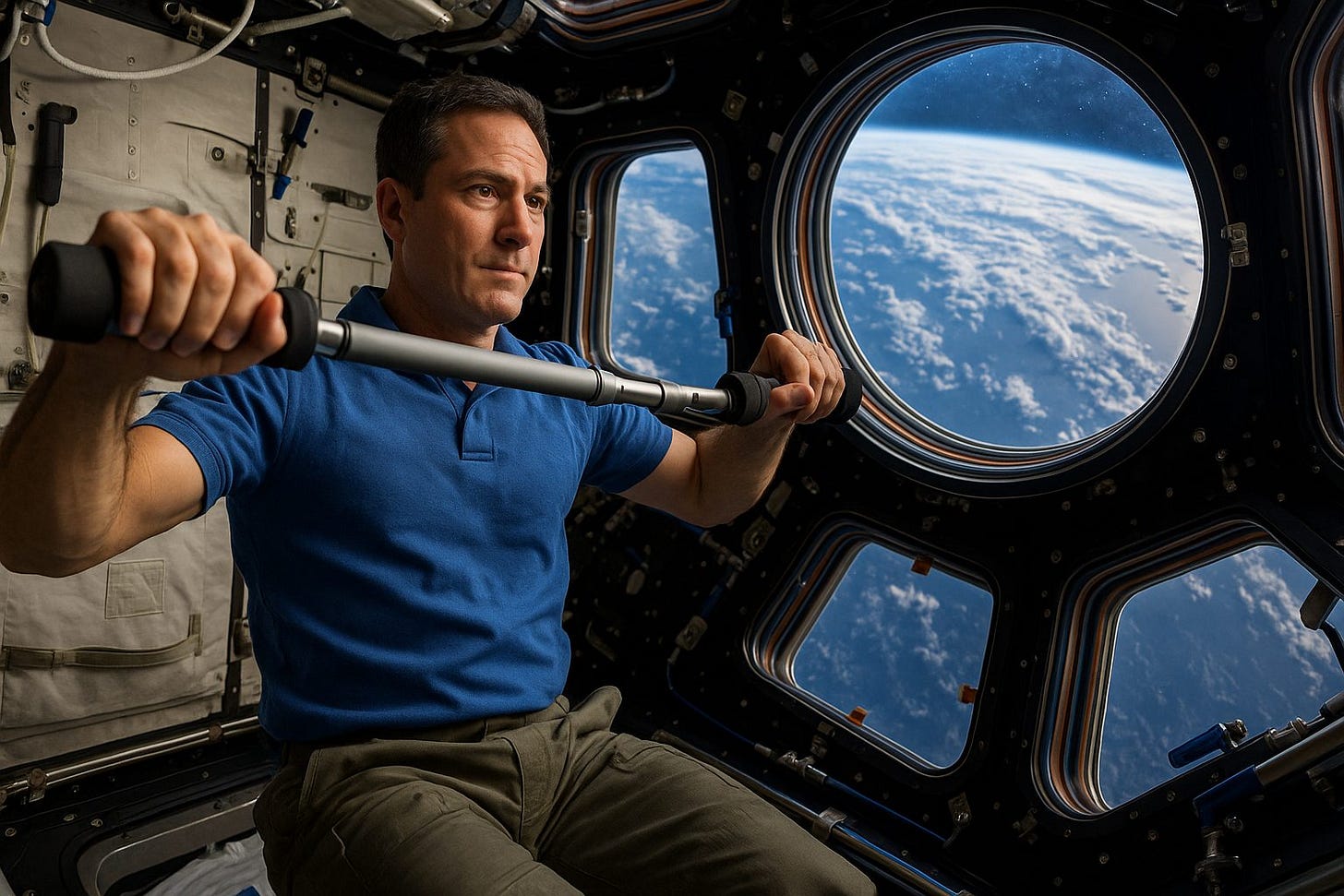5 Longevity Lessons From Space Medicine and Astronaut Research
What we can learn from astronauts so we can live longer and healthier on solid ground 🚀
Imagine spending months floating in orbit—your body quietly unraveling as gravity’s gentle tug disappears and cosmic rays bombard your cells. That’s life for an astronaut. Yet, in this extreme setting, we find profound clues about aging, health, and longevity. In this article I take you through 5 longevity lessons gleaned from the frontier of space medicine, where the void of space becomes a mirror for Earth-bound aging. You’ll see how what happens on the International Space Station matters not just for the next human in lunar boots, but for you and me. Let’s begin.
1. Gravity (matters) – for muscles, bones, and vitality
In the weightless environment of space, heavy hitters like bone loss and muscle atrophy show up fast and furious. Research by Japan Aerospace Exploration Agency (JAXA) reports that in micro-gravity, bone mass declines “ten times faster than in those with osteoporosis”; calf muscles thin by 1% a day, the equivalent of two days of bedridden rest on Earth. The link to aging is clear: as we age on Earth, we lose bone density and muscle strength. The suspended-gravity world of space accelerates that process.
The lesson? Don’t take your body’s load-bearing status for granted. Resist. Move. Load your muscles. Counter-gravity for Earth is about regular weight-bearing exercise, targeted strength training, and staying mobile so that 30, 40 or 50 years down the line you’re not creaking.
🧗♀️ CTA: Start a mini resist-training routine this week—just 20 minutes, twice.
2. Radiation, isolation & stress — aging’s unseen accelerators
Spaceflight presents unique hazards: cosmic radiation, micro-gravity, isolation and confinement. The National Aeronautics and Space Administration (NASA) groups them under the acronym RIDGE (Radiation I solation D istance G ravity Environment). A recent study found that astronauts on a potential Mars-mission-length journey could face a 33% increased lifetime risk of dying from cancer just from radiation exposure. On the flip side, research also shows space is being used as a reverse-aging lab: cells in space show signs of accelerated aging (more on that later).
For longevity we learn that environmental stressors, even subtle ones, matter. We might not face cosmic rays in our living room, but we do face poor sleep, circadian disruption, chronic stress, pollutants, sedentary behaviour. These accelerate wear-and-tear.
The takeaway: optimise the underlying environment. Sleep well, control light exposure, manage stress, minimise man-made toxins. Your body isn’t a sealed space capsule, but you can treat it like one.
3. Circadian rhythms: timing is everything
In space, your internal clock goes haywire. Without day-night cues, astronauts must fight to keep a regular schedule. JAXA emphasises—”keeping regular hours,” controlling light levels, managing stress—is crucial. On Earth, we may take rhythm for granted, yet circadian disruption links to obesity, diabetes, cardiovascular disease and presumably shorter healthspan.
The space-lesson: structure your day. Eat meals at roughly the same time. Sleep when your clock says sleep. Let daylight in. Don’t treat your body like a guest astronaut in a zero-gravity pod. Establish rhythm.
🕰 CTA: For the next week, fix your breakfast time and stick to it (even on weekends). See how you feel.
4. Stem cells & repair: the ultimate inside-out health insight
The crown jewel of recent research: a study published in 2025 reveals that human hematopoietic stem and progenitor cells (HSPCs) flown to space showed hallmarks of accelerated aging—telomere attrition, DNA damage, reduced self-renewal. In short: space acts as a biological stress-test, compressing decades of aging into weeks.
Why does this matter for longevity? Because aging isn’t just wrinkles and grey hairs—it’s at the cellular and stem-cell level. If space reveals what weakens repair systems fastest, then on Earth we can target those same systems earlier: stem-cell health, mitochondrial function, DNA repair. The futuristic becomes actionable.
Tip: Make your body’s “repair crew” happy. That means good sleep, nutrition, targeted physical activity, and minimising chronic inflammation. These are the counter-measures; the astronauts already live the stress, we just borrow the lesson.
5. Technology & counter-measures: borrowing astronaut gear for Earth
When the body falters in orbit, engineers and medics scramble—exercise machines in zero-gravity, wearable sensors, artificial gravity studies, advanced monitoring. Research on musculoskeletal adaptations in space shows promising tech like sensor-integrated suits and exoskeletons could help both astronauts and aging populations on Earth. At UTHealth Houston, the space-medicine team emphasises the translational value—finding therapies for rural clinics and aging patients from microgravity research.
For us, that means: leverage tech and data. Smart watches that track sleep and HRV (heart-rate variability). Resistance-bands at home. Posture sensors. Even simple apps reminding you to stand up and move. If it’s good enough for astronauts, it’s certainly good enough for longevity on Earth.
💡 CTA: Pick one wearable or app that you’ve ignored and commit to using it daily for 30 days. Track one metric (sleep quality, steps, HRV) and review the change.
Final Thoughts
Space medicine might sound like sci-fi, but it’s really about humans under extreme stress—and what that tells us about normal humans under long-term stress (aka aging). The five lessons above draw from the frontier and bring the insight home: gravity matters, environment matters, rhythm matters, repair matters, and tech helps.
Here’s your question: What’s one thing you’ll change this week to align with these longevity lessons?
Think of it like your personal astronaut protocol—only you don’t need a spacesuit. You just need discipline, a little tech, and a good bedtime. Your future self will thank you. 🚀


